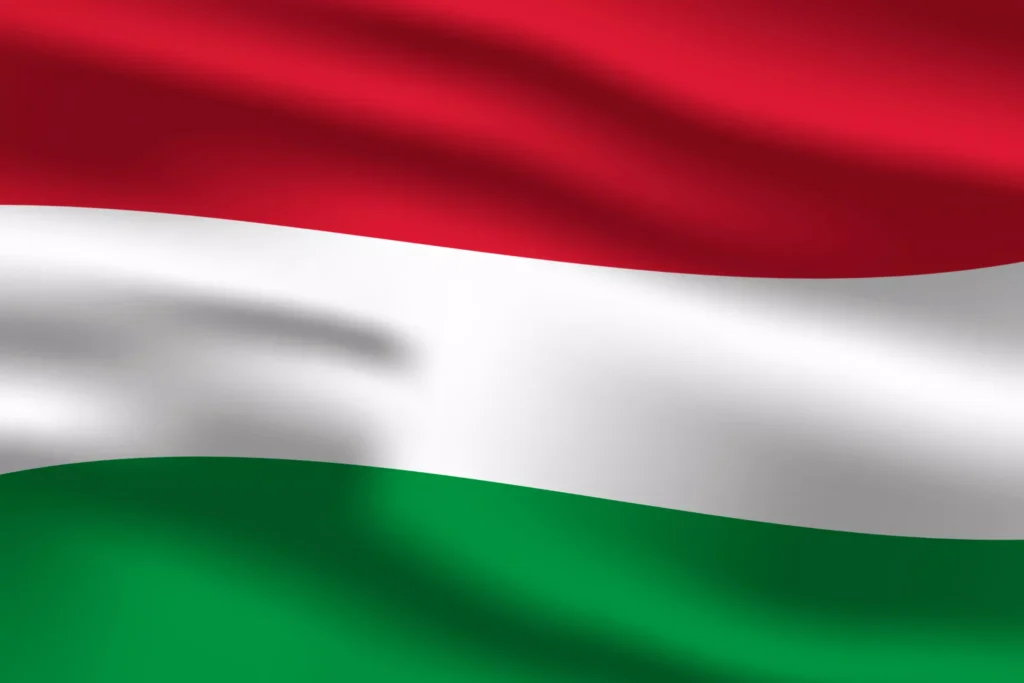The Hungary flag has developed over centuries of rich history, with the iconic red-white-green tricolor design greatly connected to Hungarian identity. Hungary is a landlocked country in Central Europe with a history going back over a thousand years. Located in the Carpathian Basin, it borders Slovakia, Ukraine, Romania, Serbia, Croatia, Slovenia and Austria.
General Information About Hungary
Country Information
- Location: Central Europe, northwest of Romania
- Capital: Budapest
- Population: 9.7 million (2020 estimate)
- Language: Hungarian (official), English, and German widely spoken
- Government: Unitary parliamentary constitutional republic
- Currency: Hungarian forint (HUF)
- Economy: $35,640 (2021) GDP per capita
- Religion: Christians
Table of Content
Flag History of Hungary
Hungary Kingdom during the Middle Ages
Color Of Hungary Flag
Symbolism of the Flag of Hungary
Frequently Asked Questions
Flag history of Hungary
The current flag of Hungary was adopted in 1957. It has three equal horizontal bands of red, white, and green. Earlier Hungarian flags were similar tricolors of red, white, and green dating back to the nationalist revolution of 1848. The Hungarian flag is based on the colors of the Hungarian coat of arms. Red symbolizes strength, white symbolizes faithfulness, and green symbolizes hope.
Hungary Kingdom during the Middle Ages
The Kingdom of Hungary was established in 1000 AD with Stephen I as its first king. The kingdom reached the peak of its power under kings Louis I and Matthias Corvinus in the 15th century when it controlled areas of central Europe, the Balkans, and modern-day Romania. Hungary was invaded by the Mongols in 1241-42. Later it became part of the Habsburg Monarchy and Austria-Hungary until 1918.
Color Of Hungary Flag

The three colors of the Hungarian flag are red, white, and green. Red represents strength, valor, and blood spilled for freedom. White represents faithfulness, honor, and reverence. Green represents hope, revival, and the lush vegetation of the country.
Symbolism of the Flag of Hungary
The red and white stripes are derived from the coat of arms of Hungary which has a red and white striped shield. The green represents the green hills and plains of the Hungarian countryside. The flag reflects Hungary’s national colors which have been used since the Middle Ages on the coat of arms. The tricolor flag design emerged during the nationalist revolution against Habsburg rule in 1848.
Frequently Asked Questions
What is Hungary famous for?
A: Hungary is famous for its cuisine like goulash soup, paprika chicken, and Dobos cake. It’s also known for its art and architecture like the Parliament building, thermal baths, and Buda Castle in Budapest. Famous Hungarians include composers like Franz Liszt, and Béla Bartók, artists like Victor Vasarely, and inventions like the Rubik’s Cube.
What languages are spoken in Hungary?
A: The official and dominant language is Hungarian. It is a Uralic language unrelated to most other European languages. Other languages like English, German, Russian, and Romanian are also spoken by some portion of the population.
What is the capital and largest city of Hungary?
A: The capital and largest city is Budapest. It is one of the largest cities in the EU with about 1.7 million people in the city proper and over 2.5 million in the metro area. Other major cities include Debrecen, Szeged, Miskolc and Pécs.
What is the currency of Hungary?
A: The official currency of Hungary is the Hungarian forint (HUF). Hungary is part of the European Union but not the Eurozone, so it does not use the euro.
What type of government does Hungary have?
A: Hungary is a unitary parliamentary constitutional republic. The head of state is the president, while the head of government is the prime minister. Hungary has a unicameral national assembly and is a multi-party democracy.
What are some key points in Hungary’s history?
A: Important historical events include the foundation of the Kingdom of Hungary in 1000 AD, the Mongol invasion in 1241, rule under the Austrian Habsburg dynasty, a revolution in 1848-1849, the formation of Austria-Hungary in 1867, and transition to democracy in 1989-90 after communist rule.




